
30 minute read
Rim Rock Farm
The University of Kansas hosts its home cross country meets at historic Rim Rock Farm, northwest of Lawrence. Before being donated to KU in 2004, the property was owned by former head track and field and cross country coach Bob Timmons and has been the home of the Jayhawks since the 1974 season. In the fall of 2006, Rim Rock Farm played host to its first Big 12 Cross Country Conference Championships. Rim Rock Farm hosted the Big Eight Cross Country Championships in 1983, 1991 and 1995, and was also the site of the 1998 NCAA Division I and II Cross Country Championships as well as numerous Kansas high school state meets.
Any runner or spectator will say that the course is quite challenging and unusual. In addition to having two covered bridges as part of the course, Rim Rock Farm also features specific hills, turns and other landmarks that are named after former Jayhawk greats. Dispersed throughout the course are silhouette statues of seven legendary Jayhawk distance runners including Herb Semper, Al Frame, John Lawson and Olympians Billy Mills, Wes Santee, Glenn Cunningham and Jim Ryun.
Advertisement
Rim Rock Farm was the vision of Coach Timmons, who, during his 23-year tenure, won two cross country conference championships. “There is something for everyone at Rim Rock Farm,” Timmons said. “Parents are afforded the opportunity to walk around throughout the course and find all the wonderful places to observe. Spectators can catch the runners three or four times throughout the event and explore the different elevations. And the runners can navigate a course that will challenge them with its obstacles and amaze them with its beauty. That’s what makes Rim Rock Farm so exciting.” Rim Rock Farm is home of the Jayhawks, but also home to former Kansas runner Steve Heffernan. After donating the course to KU, Timmons made sure that the cozy house in the middle of the farm had a full-time tenant. Heffernan is currently responsible for the farm’s upkeep, while also serving as head coach of cross country and track and field at Lawrence Free State High School.
Directions to Rim Rock Farm:
Those traveling to Rim Rock from the Kansas Turnpike are advised to take the East Lawrence exit and then travel north on Kansas Highway 24/59 (which curves to the west) for approximately 2.5 miles before turning right (north) on the asphalt road at the Midland Store. Approximately 2.5 miles later, watch for an abandoned natural gas station on the right and make a left turn (west) at that point onto a gravel road. About .25 miles ahead, make a right turn and follow the gravel road approximately 1.33 miles (north) to the course. Maps are available through the cross country office by calling (785) 864-3486 or by visiting www.kuathletics.com.
KING’S BRIDGE GLENN CUNNINGHAM FINISH

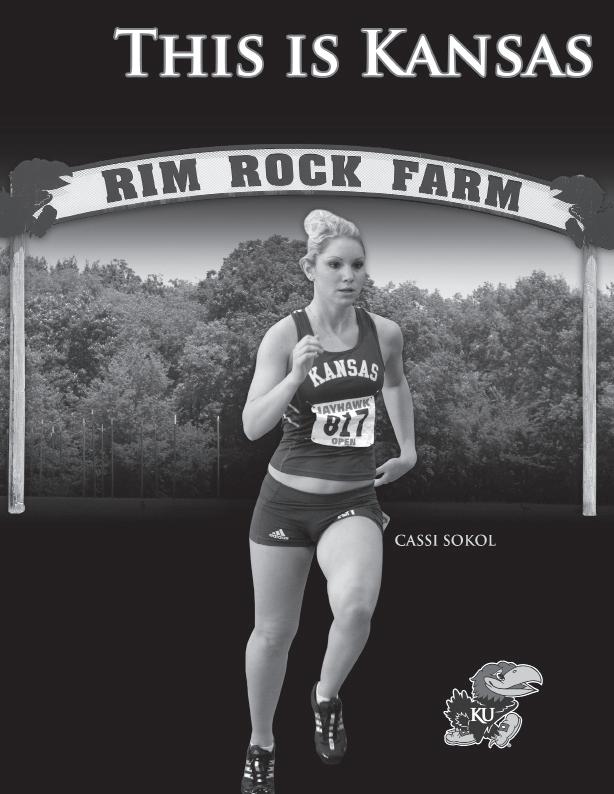

KANSAS ROOTS, GLOBAL REACH
The University of Kansas — fondly known as KU — is a tradition-rich, comprehensive research university that throughout its distinguished history has excelled in creating superior, enduring value for students, the state of Kansas and the world.
schools in allied health, architecture and urban planning, business, education, engineering, fine arts, journalism and mass communications, law, medicine, nursing, pharmacy and social welfare. KU also has expanded geographically, adding the KU Medical Center in Kansas City, Kan.; the School of Medicine clinical branch in Wichita; the Edwards Campus in Overland Park; and educational and research facilities throughout the state.
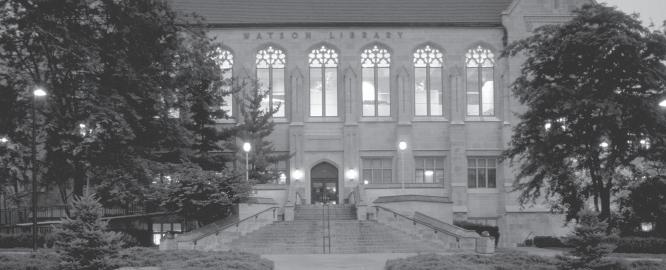
Founded by the same determined New Englanders who had emigrated to the Kansas Territory to create a state free of slavery, KU became one of the first universities of the Great Plains. The university opened its doors on Sept. 12, 1866, to 29 men and 26 women. Never in its history has KU restricted admissions based on race or gender.
Since its early years, KU has been fueled by high aspirations and today enjoys a national reputation for innovation and academic excellence. In 1890, the first chapters of Phi Beta Kappa and Sigma Xi west of the Mississippi River were chartered at Lawrence. The following year, the KU Endowment Association was established, the first foundation of its kind supporting a state-assisted university. Not to be forgotten: KU initiated interscholastic basketball competition in 1898 under the leadership of Dr. James Naismith, the inventor of the game.
With a student body of nearly 30,000 and an endowment with assets of more than $1 billion, KU has become a diversified, broad-based center of learning with professional In addition, KU prepares students for success in an increasingly global economy. Among public universities, KU ranks seventh in the nation for the percentage of its students who study abroad and 25th in the nation for the number of graduates serving as Peace Corps volunteers.
WORLD-CLASS, ACCESSIBLE EDUCATION
KU teachers have earned international distinction: 12 have been elected national academy members, 33 are fellows of the American Association for the Advancement of Science and 283 have received Fulbright awards for international study since 1950. Astronaut Steve Hawley, a Salina native and KU graduate, will return to Lawrence in fall 2008 to join the Department of Physics and Astronomy. He’ll teach students and travel the state emphasizing the importance of science education.
Led by these world-class teachers, KU students have achieved an impressive record of major honors: 25 Rhodes, 406 Fulbright, 45 Goldwater, 24 Mellon, 16 Truman, 16 Udall and nine Marshall scholarships. Architecture magazine has twice bestowed its “Home of the Year” award on KU student-built projects. The debate team has won four national titles. Journalism and math students have placed first in their respective collegiate competitions.
The attractiveness of KU to outstanding high school graduates is reflected in the current student body. In fall 2007, 30 percent of KU first-time freshmen scored 27 or higher on the ACT or converted SAT equivalent. Nationally, 15 percent of ACT test takers scored 27 or above. The average freshman ACT score of 24.6 is a record high for KU, well above the national average of 22 Last fall, KU enrolled 35 National Merit scholars, eight National Hispanic scholars and two National Achievement scholars.

For more information, or to join in supporting the University of Kansas, go to:
WWW.KU.EDU
PATH-BREAKING RESEARCH
KU is known for bioscience research in areas such as cancer, vaccines and Parkinson’s disease. The KU Cancer Center seeks to heighten Kansans’ access to breakthrough treatments by becoming a designated National Cancer Institute Comprehensive Cancer Center. Strong programs in drug development and delivery are fueled by the School of Pharmacy, which is No. 1 in the nation in portion of faculty funded by the prestigious National Institutes of Health, and No. 4 overall in funding. KU’s total research expenditures in all disciplines reached $289 million in 2007.
There are 19 KU-developed technologies in the marketplace and nearly 70 new invention disclosures a year. Professors across campus are researching critical topics such as climate change, monarch migration, payday lending businesses and avian flu. KU students contribute to major research, too. One student studied why — despite the risks — people talk on cell phones while driving.
DEEP ANALYSIS OF KU
A nationwide study by Indiana University, the “Documenting Effective Educational Practice” report, in 2004 lauded KU as a progressive research university that thoroughly engaged students in the learning process. “Many other colleges and universities will benefit from learning about KU policies and practice,” the DEEP report stated.
UNIVERSITY STATISTICS
• 20,298 undergraduates and 5,321 graduate students at the Lawrence and Edwards campuses; 2,918 students at the KU Medical Center in Kansas City, Kan. • More than 100 fields of study and more than 100 opportunities to study abroad are offered to students. • $165 million in financial aid and scholarships went to more than 16,000 students in 2007-08.
STUDENT STATISTICS
• 69.4 percent of students come from Kansas • KU students come from 50 states and more than 110 countries • More than 1,500 students come from abroad • Average age of undergraduate students: 21 • Percentage of men to women: 49.6 to 50.4 • 17.4 percent of the University of Kansas student body is multicultural • Average ACT score for freshmen: 24.6 (enhanced) • Retention rate for freshmen: 81 percent
KU TUITION & FEES
In fall 2007, KU initiated its groundbreaking Four-Year Tuition Compact for incoming freshmen. Under the compact, incoming freshmen will have no tuition increases for four years, the time it takes to complete most bachelor’s degree programs. For more information, visit www.tuition.ku.edu.
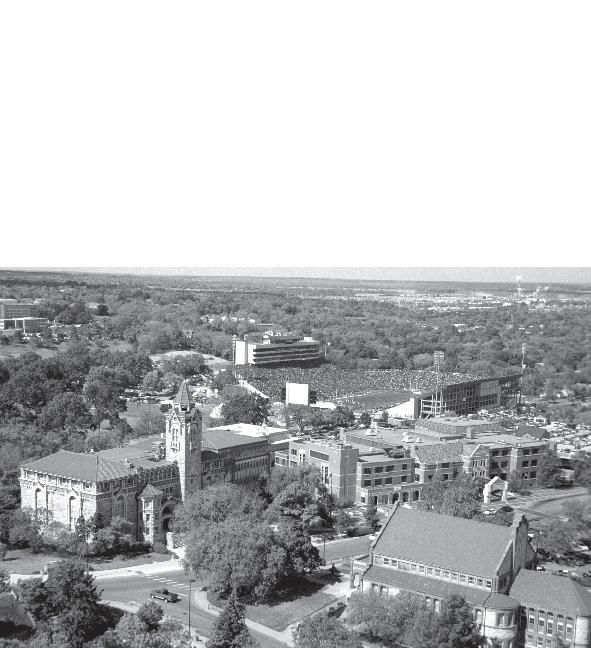
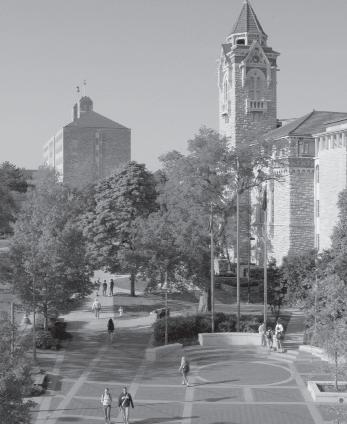
VISIT KU
The KU Visitor Center at 15th and Iowa streets is open from 8 a.m. to 5 p.m. weekdays and on select weekends. Check out the many visit options available by logging on to www.admissions.ku.edu, calling (785) 864-3911 or e-mailing visit@ku.edu.
KATIE MARTINCICH 2007 Big 12 Female Athlete of the Year
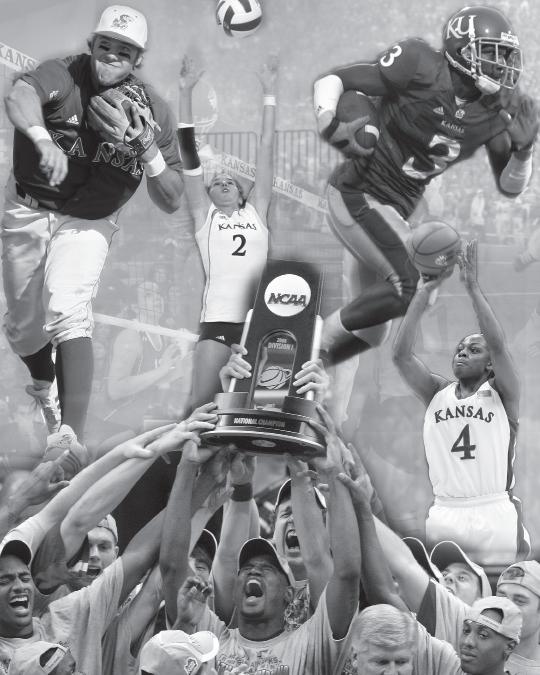
ERIK MORRISON Drafted by the Texas Rangers Two-Time All-Big 12 Honorable Mention
AQIB TALIB First Round Draft Pick by Tampa Bay Consensus All-American 2008 FedEx Orange Bowl MVP
DANIELLE MCCRAY All-Big 12 Honorable Mention
MEN’S BASKETBALL 2008 National Champions Big 12 Champions Four-Straight Years Big 12 Tournament Champions Three-Straight Years
EMILY POWERS U.S. Women’s Open Qualifier All-Big 12 Selection
CRYSTAL MANNING NCAA Outdoor All-American Big 12 Indoor Long Jump & Triple Jump Champion
MAGDALENA TOKARCZYK All-Big 12 First Team Singles
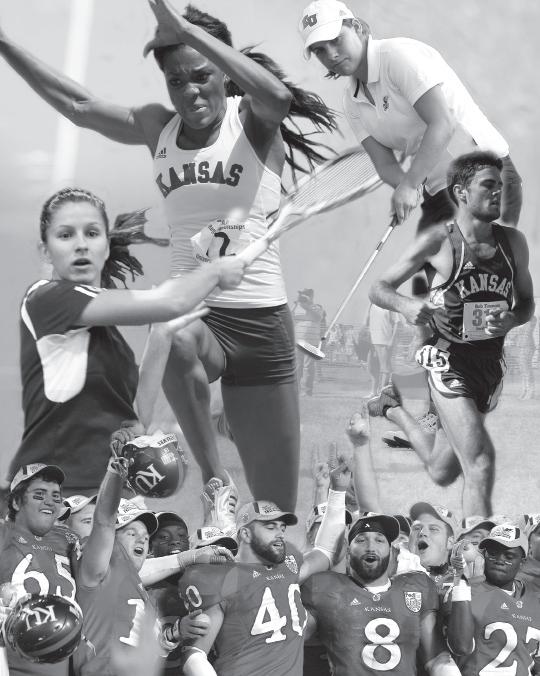
COLBY WISSEL Two-Time All-American Three-Time All-Big 12 Selection
FOOTBALL 2008 FedEx Orange Bowl Champs School record 12 wins in 2008
RIM ROCK FARM
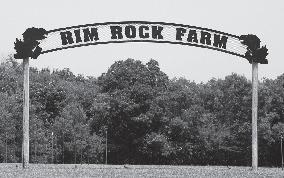

HOREJSI FAMILY ATHLETICS CENTER
HOGLUND BALLPARK



ROBINSON NATATORIUM
KIVISTO FIELD AT MEMORIAL STADIUM
JAYHAWK SOCCER COMPLEX



ARROCHA BALLPARK FIRST SERVE TENNIS CENTER
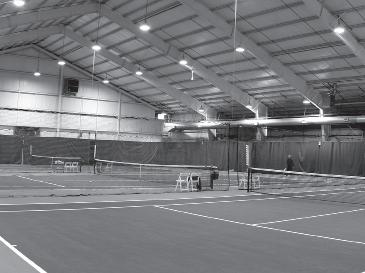

JIM HERSHBERGER TRACK AT MEMORIAL STADIUM
ALLEN FIELDHOUSE
Lew Perkins Director of Athletics
Lew Perkins has served as Director of Athletics at the University of Kansas since June 2003. He arrived at KU after achieving nationally recognized success as athletics director at the University of Connecticut. Kansas Athletics has experienced tremendous growth and success during Perkins’ short tenure.
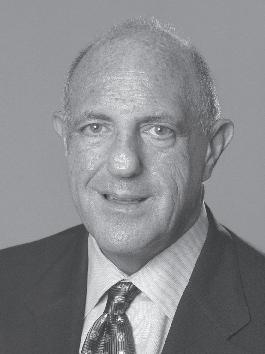
• In the spring of 2008, the studentathletes in KU’s 18-sport program achieved unprecedented success in the classroom. Eleven KU teams posted 3.0 grade-point averages or better and 282 studentathletes on active rosters (58 percent) posted a 3.0 GPA or higher, including 58 with perfect 4.0 GPA’s. Kansas student-athletes earned a combined 3.03 grade-point average during the 2008 spring semester, setting an Athletics Department-record for a spring semester. • The football team won the 2008 Orange Bowl, capping a school-record 12-win season, and the team has been bowl-eligible in four of the last five years; • The men’s basketball team won the 2008 NCAA Men’s Basketball Championship, reached the Elite Eight of the 2004 and 2007 NCAA Championships and has won the last three Big 12 Conference regular-season championships, as well as the last two Big 12 tournament titles; • The women’s volleyball team has appeared in three NCAA tournaments, reaching the second round in 2003 and 2004; • The women’s soccer team has appeared in two NCAA tournaments, reaching the Sweet 16 in 2003; • The softball team won the Big 12 Championship in 2006 and reached the NCAA tournament for the second straight season; • The baseball team won the Big 12 Championship in 2006 and reached the NCAA tournament for the first time since 1994; • The women’s basketball team reached the 2008 and 2006 Women’s National Invitation Tournament; • Several track-and-field student-athletes have won NCAA titles, and many have received All-America and All-Big 12 honors. level, Perkins has served as Chair of the Big 12 Board of Athletics Directors and as a member of the Big 12 Television Committee. In spring 2005 he was named to the Board of Directors of the Naismith Basketball Hall of Fame. Additionally, he is a member of the Gatorade Board of Directors.
At Connecticut (1990-2003), Perkins was instrumental in guiding UConn athletics to impressive growth - athletically, academically and financially. His leadership influenced six NCAA Division I National Championships.
He was rewarded in 2000 as the inaugural winner of the National Athletic Director of the Year Award as selected by Street & Smith’s Sports Business Journal, in conjunction with the National Association of Collegiate Directors of Athletics (NACDA).
A native of Chelsea, Mass., Perkins was inducted into his high school Hall of Fame in 1989. A highly recruited basketball player, he played at the University of Iowa (1965-67) for Hall of Fame coach and KU graduate Ralph Miller. Perkins earned his undergraduate degree there in 1967.
Perkins served as Director of Athletics (1969-80) and head basketball coach (1969-79) at the University of South Carolina Aiken as that institution grew from a junior college to a four-year institution. He received his master’s degree in education (1975) from the University of South Carolina. Perkins delivered the commencement address and received an honorary Doctor of Education degree at USC Aiken in May 2005. Perkins also has served as athletics director at the University of Maryland and Wichita State University, and associate director of athletics at the University of Pennsylvania.
Perkins is married to the former Gwen Flaum. Like Lew, Gwen earned an undergraduate degree from Iowa and a master’s degree in education from the University of South Carolina. They have two daughters - Amy (husband Brandon Macneill) and Holly - and two granddaughters (Caroline and Alexandra Macneill).
Kansas Athletics fundraising has reached unprecedented levels. Under Perkins, KU’s $27-million athletics budget has grown to more than $55 million. That fundraising, including landmark apparel and corporate-partner contracts, has resulted in greater services for KU coaches and student-athletes, and numerous upgrades in KU’s athletics facilities:
• The Booth Family Hall of Athletics, which opened in January 2006 in Allen Fieldhouse, celebrates the tradition and history of Kansas Athletics; a beautiful Kansas
Athletics Hall of Fame exhibit was unveiled in the Hall of Athletics in February 2008. • The spirit and aura of Allen Fieldhouse has been enhanced by renovations that were completed prior to the 2005-06 season and include freshly painted bleachers, new windows, new lighting and sound systems, and a new center-hung scoreboard, which includes a large, state-of-the-art video board; • The baseball complex now includes an indoor hitting facility and a new scoreboard, complete with a large, state-of-the-art video board; • The Anderson Family Football Complex and two new practice fields - adjacent to Kivisto Field at Memorial Stadium - have recently been completed; • A new Aquatic Rehabilitation Center houses three Hydroworx pools that enhance rehabilitation efforts under the guidance and supervision of the University of
Kansas Sports Medicine Staff.
ATHLETICS DIRECTOR LEW PERKINS WITH WIFE, GWEN, AND DOG, BENSON.

Dr. Robert Hemenway University Chancellor
Robert Hemenway’s life has been marked by accomplishment as an administrator, teacher and scholar.
As the 16th chancellor of the University of Kansas, he is the chief executive of the university, which includes the main campus in Lawrence, the KU Medical Center in Kansas City, Kansas, the Edwards Campus in Overland Park and the School of Medicine-Wichita, along with facilities in Garden City, Hays, Parsons, Pittsburg, Topeka and Yoder.

Under Hemenway’s leadership, a growing number of KU academic programs have received national recognition, and the achievements of faculty and students have cemented KU’s position as an international research university. U.S. News & World Report ranks 12 KU graduate programs in the top 10 nationwide and 26 in the top 25. KU’s graduate programs in city management and urban policy and special education are ranked first in the nation.
KU enrolls more Kansans than any other university, with 70 percent of its more than 29,000 students coming from the Sunflower State. The diverse student body is highly talented, with an average ACT score well above the national average. KU students regularly win the nation’s most prestigious awards, including Rhodes, Goldwater, Marshall, Fulbright, National Science Foundation and Udall scholarships. In intercollegiate competitions, KU students excel — the men’s basketball team was the 2008 NCAA Champions, the debate team ranked first in the nation for the 2007-08 season, the journalism program was first in the Hearst writing competition and the football team was the victor in the 2008 Orange Bowl.
Research at KU, a major source of Kansas economic growth, has climbed steadily, reaching $289 million in fiscal year 2007. The university’s No. 1 research priority is to achieve National Cancer Institute designation for the KU Cancer Center at the KU Medical Center in Kansas City. This designation will lead to superior cancer research and care for citizens throughout the state and region.
As a public institution, KU remains focused on working for the people of Kansas. KU doctors treat patients throughout the state, during medical outreach trips and via telemedicine. KU researchers measure groundwater levels in western Kansas, while law enforcement officers trained by KU’s Kansas Law Enforcement Training Center protect Kansans in every county.
Leaders of other universities recognize Hemenway’s administrative talents. In November 2007, he was elected to the 11-member executive committee for the Association of American Universities, an organization representing the nation’s most prestigious research universities. He has also served on the board of directors for the American Council on Education, the National Association of State and Land Grant Colleges and the NCAA Division I Board of Directors, which he chaired from 2002 to 2005.
Hemenway remains a committed scholar and teacher. He is known for his biography of AfricanAmerican novelist Zora Neale Hurston, a “Best Books” pick by the New York Times in 1978 and a Quality Paperback Book Club selection in 1991. Hemenway also stays connected to the classroom, most recently teaching an honors seminar on global poverty.
Hemenway grew up in Hastings, Nebraska. Before becoming chancellor of KU, he served as chancellor of the University of Kentucky. Hemenway and his wife, Leah, live in the Outlook, the KU chancellor’s official residence. Four of the chancellor’s eight children are KU graduates. The Hemenways have seven grandchildren.
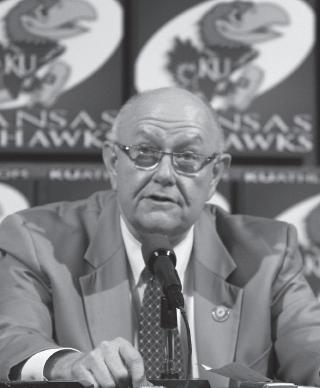
CHANCELLOR HEMENWAY WITH KU ATHLETIC DIRECTOR LEW PERKINS VISITING THE BOOTH FAMILY HALL OF ATHLETICS.

BOB DOLE

KATHLEEN SEBELIUS

GALE SAYERS
Harold Arlin
First play-by-play man for an MLB game on radio
K.S. “Bud” Adams
Owner, Tennessee Titans
Stuart Bailey
Producer of “The Daily Show”
Nancy Kassebaum Baker
U.S. Senator
Scott Bakula
Actor, (TV’s “Quantum Leap,” “Star Trek: Enterprise”)
Kay Waldo Barnes
First female mayor of Kansas City, Mo.
Etta Moten Barnett
Actress and singer - First African-American woman to entertain at the White House
Linda Zarda Cook
Executive Director of Shell Gas & Power and former CEO of Shell Canada. Named one of the most suc- cessful businesswomen in Europe.
Wilt Chamberlain
Basketball Hall of Famer
Bob Dole
Former U.S. Senator and presidential candidate
Bob Eaton
Chair of Chrysler Corp.
Paul Ehrlich
Environmental scientist, population expert and author (“The Population Bomb”). Also a MacArthur Fellow recipient.
Joe Engle
NASA astronaut on first shuttle flight
Ron Evans
NASA astronaut on Apollo 17
Alex Graves
Executive producer, (“West Wing”)
Moses Gunn
Actor (“Heartbreak Ridge” and “Roots”)
Ann Hamilton
Sculptor, MacArthur “Genius” Fellow recipient
Steve Hawley
NASA astronaut Kevin Helliker
Pulitzer Prize-winning journalist
David Hillis
Evolutionary biologist and MacArthur “Genius” Fellow
William Inge
Pulitzer Prize-winning playwright (“The Dark at the Top of the Stairs,” “Come Back, Little Sheba,” “Picnic,” “Splendor in the Grass”)
Clarence Kelly
Former head of FBI
Rebecca Kolls
Gardening expert (HGTV’s “Rebecca’s Garden,” ABC’s “Good Morning America”)
Bill Kurtis
Journalist and producer (A&E’s “Investigative Reports,” “American Justice”)
Delano Lewis
Former National Public Radio CEO and Ambassador to South Africa
Elmer V. McCollum
Scientist, discovered vitamins A, B and D
Billy Mills
Olympic gold medalist in track (only American to win the 10,000-meters medal)
Lou Montulli
Co-founder of Netscape
Alan Mulally
President and CEO of Ford Motor Company
Al Oerter
Four-time Olympic Gold Medalist
Sara Paretsky
Best-selling mystery writer (V.I. Warshawski series)
Mandy Patinkin
Actor (“Yentl,” “The Princess Bride”; TV’s “Chicago Hope” and “Criminal Minds”)
Paul Rudd
Actor (“Clueless,” “Cider House Rules”; TV’s “Friends”)
Jim Ryun
Three-time U.S. track Olympian and world-record miler, U.S. House of Representatives
Gale Sayers
Chicago Bears football star
Kathleen Sebelius
Governor of Kansas
Gerald Seib
Pulitzer Prize-winning journalist
Douglas Shane
Director of Flight Operations for SpaceShipOne, first private manned space program
Dean Smith
College basketball’s second winningest coach
Vernon Smith
Nobel Prize laureate in economics
Deanell Reece Tacha
Chief judge of the U. S. Court of Appeals for the Tenth Circuit
Clyde Tombaugh
Scientist, discovered the dwarfed planet Pluto
Kent Whealy
Founder of the Seed Savers Exchange, MacArthur Fellow
William Allen White
Journalist, Pulitzer Prize winner
Lynette Woodard
First female Harlem Globetrotter. All-time lead- ing scorer in college women’s basketball history.
Sir Robert Worcester
Market research pioneer and top British political commentator and pollster
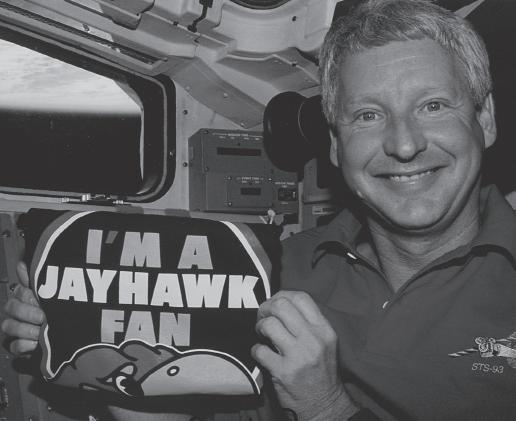
Kansas City knows how to entertain visitors. After all, from its beginnings this city has a rich history of delighting travelers with flashy amusement parks and innovative shopping areas. Whether you are visiting the home of Hallmark Cards or watching a “hog” being assembled at the HarleyDavidson Final Assembly Plant, today’s traveler will find a multitude of diverse and fun attractions. Thrill-seekers of all ages love the side-by-side theme parks, Worlds of Fun and Oceans of Fun. Modeled after the tale, “Around the World in Eighty Days,” Worlds of Fun features more than 50 rides, shows and attractions. Catch more than 60-acres of surf, sand and fun at Oceans of Fun, the Midwest’s largest tropically-themed water park. For a wild time, head to the Kansas City Zoo where hundreds of exotic animals reside in their natural habitats. Lawrence is located roughly 35 minutes west of downtown K.C.


Country Club Plaza
No trip to Kansas City is complete without a visit to the Plaza. This 14-square-block outdoor shopping and entertainment district boasts romantic Spanish architecture, European art and dazzling fountains. Designed in 1922, the Plaza features boutiques and fashionable national stores as well as distinctive restaurants, outdoor cafés and nightlife hotspots.
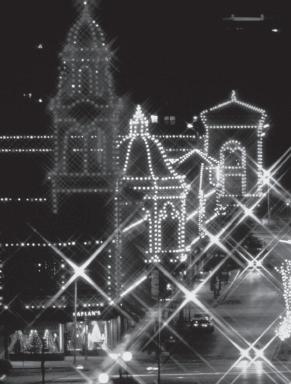
The Truman Sports Complex is home to major league sports action for the Kansas City Chiefs and Royals at the side-by-side Arrowhead and Kauffman stadiums.

In Kansas City, Kan., just off I-70 sits the Community America Ballpark, home of the Kanas City Wizards Soccer Team, and the Kansas Speedway which hosts NASCAR’s premier series, the NEXTEL Cup Series. It also brings the superstars of the Indy Racing League’s IndyCar Series, the NASCAR Busch and Craftsman Truck Series and ARCA’s RE/MAX Series to Kansas City, Kan., for an exciting season of heart-pounding motorsports action.

LAWRENCE QUICK FACTS
Lawrence Population: 81,816

Annual Average High Temperature: 67
Annual Average Low Temperature: 45
Annual Average Precipitation: 37”
Lawrence is conveniently located on Interstate 70 between Kansas City and Topeka (state capital). Kansas Highway 10 connects Lawrence to the south Kansas City metroplex. Highway 59 serves as the city’s north and south access, and Highway 40 runs parallel to Interstate 70 east and west.
Lawrence was founded in 1854 by the New England Emigrant Aid Society in an effort to keep the territory free from slavery. It is said that it is one of the few cities in the United States founded strictly for political reasons.
Lawrence boasts the most vibrant downtown shopping district in Kansas. Many have called Massachusetts Street one of the most beautiful main streets in America.
Lawrence is ranked No. 8 in The 100 Best Small Arts Towns in America by John Villani.
Both the Oregon and Sante Fe Trails run through parts of Lawrence and Douglas County.
Lawrence streets are named after the states in the order they came into the Union, beginning with Delaware.
Massachusetts was designated the “Main” street because Lawrence’s founders were from Massachusetts.
Lawrence is a city literally bustling with activity. You’ll find a wide array of exciting cultural, educational and entertainment opportunities everywhere you look.
Downtown Lawrence radiates with a cool mix of shopping, nightlife and history.
Lawrence festivals provide a wealth of musical offerings. Music is a staple in the Lawrence community. The sounds of local talent can be heard echoing through the city’s streets both day and night.
DISTANCE CHART (FROM LAWRENCE TO…)

THE SPORTING NEWS SELECTED LAWRENCE AS ONE OF THE 50-BEST SPORTS TOWNS IN NORTH AMERICA IN A RECENT REPORT.
Lawrence is not just another college community. It presents the easy-going feeling of a smaller town combined with big city cultural opportunities. A population of 81,816 that comes from widely diverse backgrounds makes Lawrence an outstanding place to live and raise a family. Psychology Today calls Lawrence one of the 25 least-stressful cities in which to live. A community that supports the University of Kansas with its heart and soul, Lawrence envelopes the students so they too think of Lawrence as their own hometown. Lawrence is well known for the arts, alternative music and downtown shops, galleries and restaurants. Topeka, Kan. .........................................27 miles Kansas City............................................35 miles Manhattan, Kan....................................91 miles Wichita, Kan........................................161 miles Omaha, Neb........................................187 miles Oklahoma City, Okla..............................298 miles St. Louis, Mo........................................301 miles Dallas, Texas........................................444 miles Little Rock, Ark....................................466 miles Denver, Colo. ......................................542 miles Chicago, Ill. .........................................578 miles Houston, Texas....................................744 miles San Antonio, Texas..............................780 miles Cleveland, Ohio...................................867 miles New York, N.Y. .................................1,240 miles Orlando, Fla......................................1,286 miles San Diego, Calif. ..............................1,735 miles
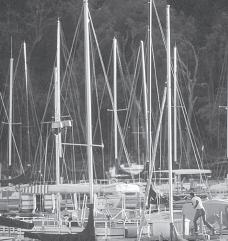
Psychology Today calls Lawrence one of the 25 least stressful cities in America.

THE ROCK CHALK CHANT
The Rock Chalk Chant has been the battle cry of KU fans for more than 80 years. This strange, traditional chant, which is among the most famous of all college cheers, was started by E.H.S. Bailey, a professor of chemistry. Bailey wanted a cheer for his Science Club. Returning from a convention in Wichita, Bailey and some associates patterned a yell after the rhythmic cadence of their train rolling along the tracks. On May 21, 1886, Bailey submitted the cheer to his club. Even though there was no football team at KU until 1890, the Rock Chalk Chant tradition steadily grew.
Before the University adopted the cheer in 1897, it consisted of “Rah, Rah, Jayhawk, KU” being repeated three times. An English professor soon suggested that “Rock Chalk” be substituted for “Rah, Rah” because it rhymed with Jayhawk. “Rock Chalk” was also symbolic of the chalky limestone formations found on Mount Oread. Professor Bailey would be amazed to hear 50,000 Jayhawk football fans shouting the cheer he gave his Science Club in 1886; a cheer that Teddy Roosevelt said was the best he had ever heard.
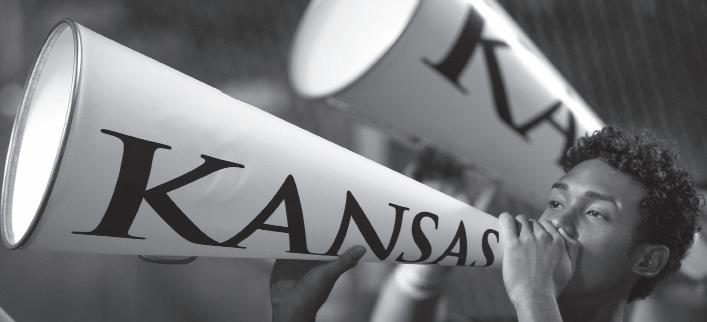

CAMPANILE HILL
Campanile Hill forms the picturesque backdrop for Memorial Stadium. On a sunny fall Saturday, the “Hill” is transformed into a congregating place for watching Jayhawk football, sunning and barbequing. Potter Lake, just to the southeast of Memorial Stadium and at the bottom of Campanile Hill, adds to the beauty of the Kansas campus.
WAVING THE WHEAT
Since the early days of KU football, it has been a ritual of Jayhawk fans to “wave the wheat” following every Kansas scoring drive. The ritual consists of fans waving their arms in the air, an activity which, when done by a large Memorial Stadium crowd, resembles a breezy Kansas wheat field.
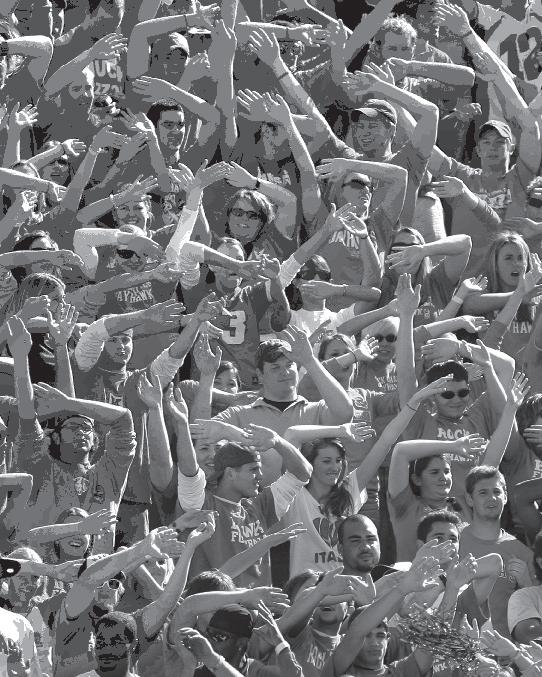
THE NICKNAME
During the Civil War a regiment raised by Kansas Governor Charles Robinson called itself the “Independent Mounted Jayhawks” (later officially the First Kansas Calvary and then the Seventh Kansas Regiment). By the end of the Civil War the word Jayhawk was associated with the spirit of camaraderie and the courageous fighting qualities that characterized efforts to keep Kansas a free state.
By 1886, the University of Kansas had adopted the mythical bird as part of the KU yell. When the university’s football team first took the field in 1890, it seemed only natural that they should be called Jayhawkers. Few colleges and universities have such a meaningful symbol, one so deeply associated with the struggles of the people who founded them.
THE FIGHT SONG
George “Dumpy” Bowles, a student with the class of 1912, longed to make a great contribution to KU spirit, but wasn’t athletic enough to do historic deeds on the athletic field. He turned to music and produced some outstanding student musical shows.
A song in one of these shows was “I’m a Jayhawk.” Written in 1912, it was dormant until 1920 when a growth in school spirit brought out “I’m a Jayhawk” once more. The song contributed to the raising of funds to build both the stadium and union as World War I memorials. The 1926 glee club made it known nationally.
Big 12 Conference Communications Staff
Dan Beebe
Big 12 Commissioner
Bob Burda Asst. Commissioner Communications
Rob Carolla
Director of Communcations
Carmen Branch
Asst. Director of Communications
Joni James Lehmann
Assoc. Dir. of Communications
Felicia Michael Will Hancock Intern
Bonnie Ryan Will Hancock Intern
The Big 12 Conference has established a consistent level of national success on the field and in the classroom as it enters its 13th season in 2008-09. Since it began play in 1996-97, the Conference can boast 31 team crowns and over 385 individual NCAA Championships. The success continued during 2007-08 as Kansas captured the Big 12’s first national title in men’s basketball, while the league added 31 individual crowns. Over the past four seasons a total of 12 NCAA trophies have been hoisted by Big 12 institutions, with at least one national crown won in all but one year for the Conference, including each of the past 11 seasons. The Big 12 leads all conferences with five appearances in Bowl Championship Series title games. League squads have played for the football national championship five times in the last nine years with berths in 14 BCS games overall, including two in 2007. The Big 12 led all conferences with four teams ranked in the Top 10 in the final national polls a season ago. In addition, an all-time high eight league players earned consensus All-America recognition in 2007, more than any other conference. In basketball, nine men’s and women’s teams have advanced to their respective Final Fours in the past seven seasons as the Big 12 continues its place among the elite intercollegiate athletic conferences. The six men’s Final Four participants since 2002 is more than any conference. Numerous national honors have been won by basketball student-athletes during the league’s history, with Michael Beasley (Kansas State), D.J. Augustin (Texas) and Courtney Paris (Oklahoma) the most recent to garner accolades as consensus All-America in 2007-08. The Big 12 and its member institutions are committed to a competitive environment where sportsmanship and fair play take center stage. Whether on the field, in the classroom, or within the community the student-athletes, administrators, coaches and game officials of the Big 12 support the highest ideals in sportsmanship. Big 12 student-athletes also do well in garnering national academic recognition. Sarah Pavan (Nebraska) was named Academic All-America of the Year in volleyball the past two seasons by ESPN The Magazine and College Sports Information Directors of America with a 4.0 grade-point average in Biochemistry. She also won the national academic honor presented for all sports in 2006-07 and was named recipient of the prestigious 2006-07 Honda-Broderick Award as Collegiate Woman Athlete of the Year. She is the first athlete since the Big 12 was formed to earn the accolade. In addition to his athletic accomplishments, Augustin was an Academic All-America First Team choice. In its history, the conference can boast of over 300 academic honorees, averaging more than 25 each season. The Big 12 can boast of other stories that combine on and off the field success. Patience Knight (Texas Tech) was the recipient of the Honda Inspiration Award in 2008, given to an outstanding female college athlete who overcomes adversity to excel in her sport.
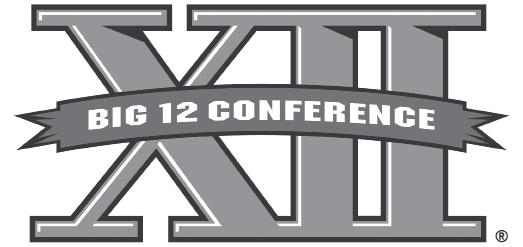
71
She was diagnosed with a cancerous tumor in 2007, but rebounded to win All-America honors at the 2008 NCAA Indoor Track & Field Championships. Competitive excellence, scholarship and sportsmanship are all equal components of the Big 12 philosophy. All-Big 12 teams and Academic All-Big 12 squads are recognized for each sport at the end of their respective seasons. At the end of each academic year, the Conference honors its top male and female student-athletes with the Big 12 Athlete of the Year and Big 12 Sportsperson of the Year awards. Institutions can also nominate student-athletes for the prestigious Dr. Prentice Gautt Postgraduate Scholarships at the end of each academic year. A total of 201 scholars have received over $1.2 million in postgraduate financial aid through the first 12 years of the program. The Big 12 sponsors 21 sports. Men’s squads include baseball, basketball, cross country, football, golf, indoor track & field, outdoor track & field, swimming & diving, tennis and wrestling. Women’s teams are fielded in basketball, cross country, golf, gymnastics, indoor track & field, outdoor track & field, soccer, softball, swimming, tennis and volleyball. The conference is made up of 12 institutions that have shared many traditional rivalries throughout their histories. Member schools include - Baylor University, University of Colorado, Iowa State University, University of Kansas, Kansas State University, University of Missouri, University of Nebraska, University of Oklahoma, Oklahoma State University, University of Texas, Texas A&M University and Texas Tech University. The institutions created a league that encompasses seven states, over 45 million people and television households in 18 of the top 100 markets within its geographic footprint. The conference conducts championships for 20 of its 21 sports. Each championship helps to determine teams and/or individuals that will represent the Conference in national postseason competition. The winner of the Big 12 football championship game earns the league’s berth into the prestigious Bowl Championship Series. In the last several years the Big 12 has increased its bowl agreements and expanded television opportunities for all sports through contracts with ABC/ESPN, FSN and CBS College Sports. Most recently, the league renewed and expanded its multi-year arrangement with ABC/ESPN, Inc. The new contract begins in 2008-09. In its first 12 years, the Conference has distributed more than $1 billion to its 12 member institutions. The Big 12 staff administers to over 4,600 student-athletes in 21 sports. The conference is headquartered in Irving, Texas.
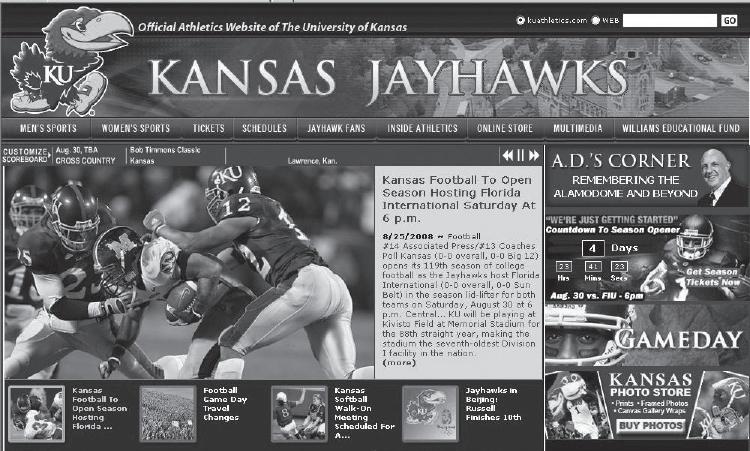
KU CROSS COUNTRY ON THE WEB:
• Complete coverage of Kansas cross country, including news releases, meet recaps and results • Updated roster, schedule and season statistics • Download and print Kansas cross country meet notes • Photo galleries for home meet • Feature stories and interviews featuring current student-athletes • Press releases • Information on upcoming events • Results from previous seasons • Contact information
WWW.KUATHLETICS.COM IS THE OFFICIAL SOURCE FOR:
• News and notes on all Kansas teams • Scores and highlights • Feature stories • Jayhawk merchandise • Tickets











